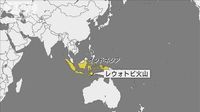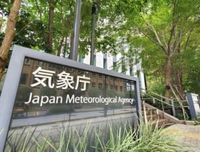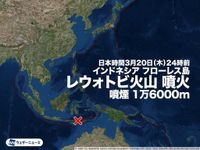A significant eruption occurred at Mount Lewotobi in Indonesia on March 21, 2025, around 12:40 AM Japan time, sending ash plumes soaring to approximately 16,000 meters. The Japan Meteorological Agency (JMA) is currently investigating any potential tsunami risks to Japan, though preliminary assessments indicate no immediate threat to the country.
The eruption's robust activity was observed by Japan's Himawari 9 meteorological satellite, which tracked the towering plumes as they reached alarming heights. As the volcano, situated in Indonesia’s Lesser Sunda Islands on Flores Island, became more active, fears grew that it could trigger similar events experienced during past eruptions.
In a statement, the Japan Meteorological Agency acknowledged that their monitoring was heightened due to concerns that the eruption could lead to unusual tsunami activity, recalling the January 2022 eruption of Hunga Tonga-Hunga Ha'apai, which resulted in tsunamis that reached Japan's coast. That precarious situation urged vigilance, prompting officials to maintain a close watch on tidal levels.
However, following observations made at around 3:00 AM on the same day, the JMA confirmed that no tidal changes had been noted at either domestic or international tide measurement stations. "As of 3:00, tidal changes have not been observed at overseas or domestic tide level observatories," said a spokesperson from the Japan Meteorological Agency, highlighting that the risk of a tsunami reaching Japan as a result of the Lewotobi eruption remains minimal.
Recent history of volcanic activity in the region is not without urgency. The Lewotobi volcano had already demonstrated its volatility with significant eruptions last November resulting in casualties. It seemed the cycle of eruptions had picked up pace since late October 2024, which raised alarms about the volcano's current state.
Reports indicate that last year's activity was intense, with an eruption on November 4 causing a pyroclastic flow that brought ash clouds up to 12,000 meters. By November 7, the eruption's intensity had escalated further, with smoke rising as high as 16,800 meters. Such occurrences log the ongoing threat posed by the Lewotobi volcano, and residents are urged to remain aware and prepared.
In light of the current eruption, the JMA is proactive about public safety, advising the populace to remain alert and vigilant. "We are currently monitoring the situation and urging people to stay informed," one JMA official stated. This sufficiency of caution was reflected in the lack of tsunami alerts for Japan, differentiated from the more catastrophic events in the past where eruptions caused significant disturbances.
Historically speaking, major tsunamis caused by volcanic eruptions have been infrequent; recent notable instances are limited to the Krakatoa eruption in 1883 and the aforementioned eruption of Hunga Tonga-Hunga Ha'apai. These events were both directly tied to extreme atmospheric pressures generated during volcanic activity.
Despite the low probability of tsunami generation from the current eruption of Lewotobi, experts remain watchful, recalling how past eruptions triggered unusual waves. Similar announcements had been issued following eruptions across various volcanoes including the Manam in March 2022 and the Bezymianny in May 2022, none of which resulted in actual tsunami impacts.
The Japan Meteorological Agency reinforces this cautious optimism while reinforcing preparedness protocols for the public. They continually assess the volcanic activity and are positioned to issue further warnings should the situation evolve. While we're fortunate to avoid tsunami threats from the Lewotobi eruption, there lies an ongoing emphasis on diligent monitoring and clear communication to reassure residents of coastal zones that were previously rattled by nature's unpredictable fury.
In summary, the eruption of Mount Lewotobi underscores the continuing vulnerabilities of volcanic regions, especially in relation to coastal nations like Japan. Preparations and alerts remain critical even as the risk of immediate danger appears low. Authorities will continue their surveillance of both the eruption and its potential environmental impacts, providing necessary updates to ensure public safety in the wake of such natural phenomena.









